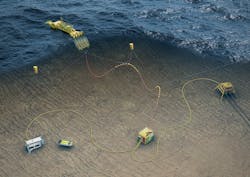Wave power developer Mocean Energy and energy storage specialist EC-OG are collaborating with Chrysaor, Modus, Baker Hughes, and the Oil and Gas Technology Centre (OGTC) in Aberdeen. They plan to demonstrate how wave power coupled with underwater energy storage can reduce the carbon footprint of powering subsea oil and gas production equipment and AUVs.
The OGTC and the project partners are funding the demonstrator, which will be tested at EC-OG’s onshore facility in Aberdeen this July and August, followed potentially by sea trials later in the year.
It follows an earlier study in 2020, part funded by the OGTC, which confirmed the environmental benefits of the design concept that will be used for the upcoming campaign.
Cameron McNatt, Mocean Energy’s managing director, said: “Our technology uses renewable energy from waves to deliver low carbon power for subsea equipment, including tiebacks…
“We will demonstrate – in onshore conditions – how our wave device will deliver power and communication to subsea equipment.”
Nigel Ward, managing director at Modus, added the program would “provide temporary or semi-permanent modular series residency for hybrid autonomous underwater vehicles, recharged subsea and controlled from shore using ‘over-the-horizon’ technology. This innovative and flexible approach to survey and inspection will reduce the numbers of personnel required offshore, providing significant benefits and cost savings, without compromising quality.”
John Kerr, subsea production systems and technology director for Baker Hughes, Oilfield Equipment concluded: “Many subsea oilfield production systems will transition to all-electric operations in the not too distant future…
“We are excited to be part of this project as we will be able to simulate the ability of the system to power and communicate with the equivalent of a four-well Baker Hughes all-electric subsea production system.”
Other applications could include remediation of faulty umbilical cables in existing developments; fast track solutions for single well tiebacks; and ultra-long step outs of greater than 200 km (124 mi), where local renewable power generation could make these developments more environmentally and economically viable.
Report highlights subsea boosting opportunities
Rystad Energy has identified more than 200 projects globally where subsea boosting could make an immediate impact by increasing production profitably. The report was produced using the company’s new Subsea Processing Screening Tool – a dashboard that analyzes the different components of subsea processing – evaluating offshore projects worldwide and identifying the best candidates for subsea boosting. It has quantified costs, profits, and the potential extent of increased output that are related to applying this sparsely-used technology.
The increase in recoverable reserves for the top 100 projects, out of more than 200 projects identified where subsea boosting would be profitable, averaged 61 MMbbl of oil per project, with the amount varying widely depending on the size and location of each project. For every extra barrel of oil produced due to subsea boosting, operators can expect a profit of $11.30 on average, according to the analyst.
The average investment cost to apply the subsea boosting solution for the above projects is at about $475 million, again varying widely depending on project characteristics.
Most of the identified candidate projects, nearly 50, are in the US. The other countries rounding out the top 10 list are Brazil, Angola, Norway, the UK, Guyana, Nigeria, Ghana, Malaysia, and Suriname.
The 10 companies that operate most of these projects identified by Rystad Energy are Petrobras, ExxonMobil, Shell, Equinor, bp, Chevron, Eni, LLOG, Murphy Oil, and Apache.
Subsea boosting is the most mature technology within the subsea processing toolbox, and yet, much like the other subsea processing technologies, it is not widely adopted. Framo Engineering (now OneSubsea) installed the first subsea booster pump on Shell’s Draugen platform offshore Norway in 1993. Since then only another 50 projects have installed boosting equipment worldwide.
Erik Vinje, analyst with Rystad Energy’s energy service team, said: “Subsea boosting offers significant value creation, both for brownfield and greenfield developments, by reducing the wellhead backpressure at the seabed, which in turn accelerates production and increases total recoverable resources.”
The project candidates deemed suitable in this analysis were identified by studying field characteristics and calculating the net present value from installing a subsea boosting system. This process considered the impact to the production profile, any increase in recoverable reserves and costs related to equipment, installation, power investments, and topsides modification. About 50% of the candidate projects are brownfield initiatives, where the quicker subsea boosting is applied, the larger the positive impact.
One of the main reasons for the low adoption rate seen thus far for boosting equipment relates to the reliability of these units, the analyst said. The operational downtime ratio of the pumps was a critical issue in the early days of subsea boosting, as any need for intervention involved expensive specialized vessels or drilling rigs to repair the unit. However, with advancing technology, the reliability of subsea units has increased in recent years.
About the Author
Jessica Stump
Editor
Jessica Stump is editor of Offshore Magazine. She uploads and writes news to the website, assembles surveys and electronic newsletters, and writes and edits articles for the magazine. She was the summer editorial intern at Offshore in 2009 and 2010 before joining full time in April 2011. She has a journalism degree from Texas Tech University.

